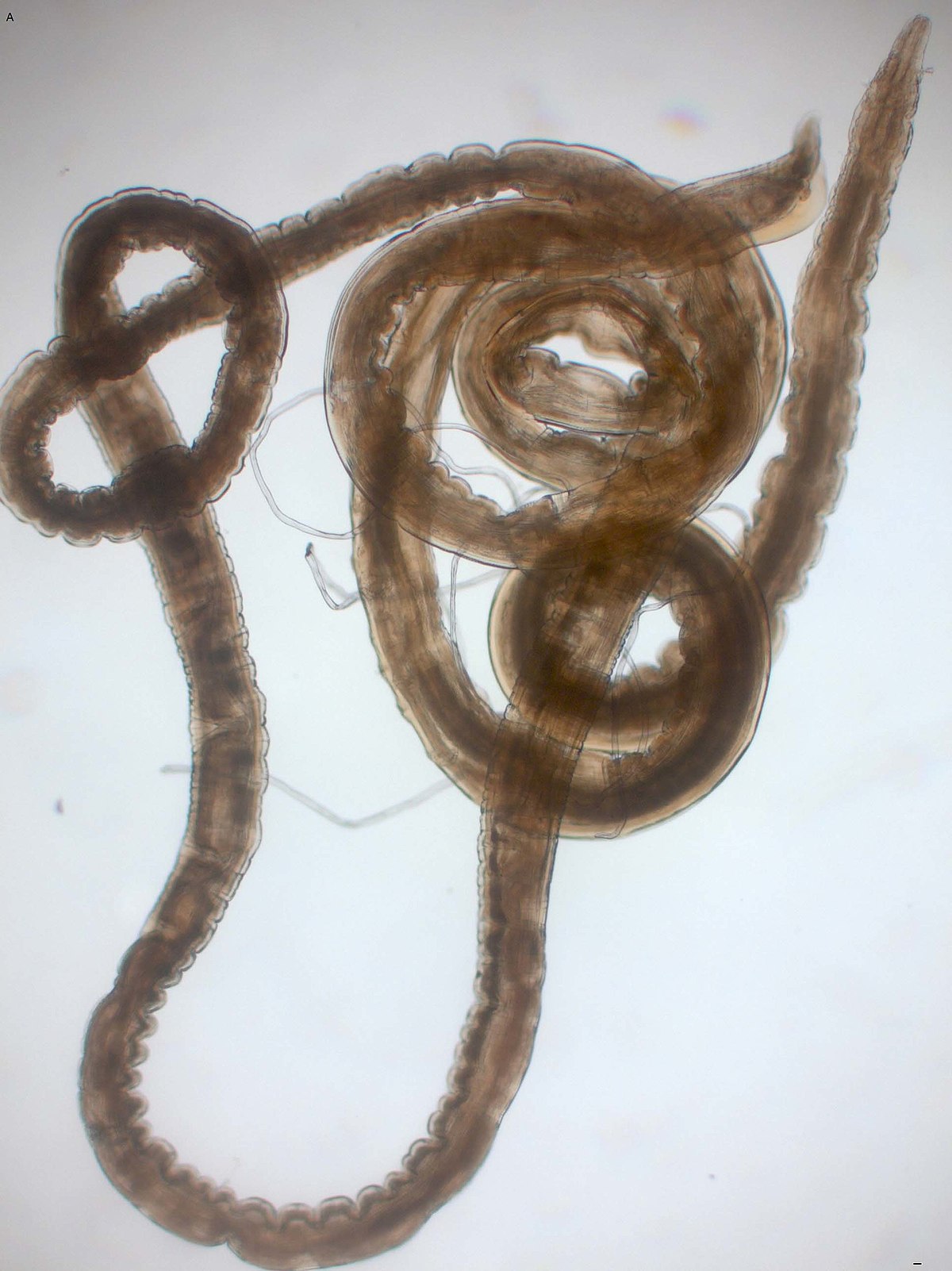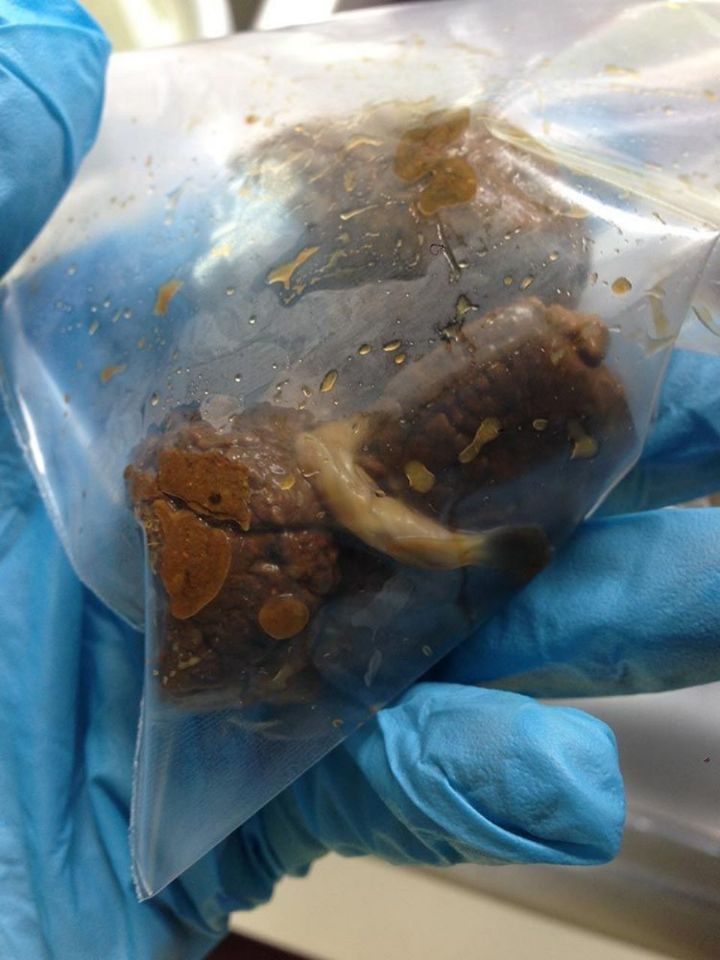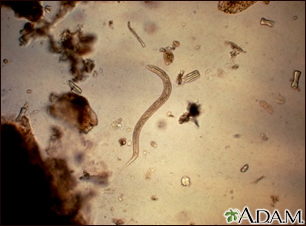Know human intestine worms, their symptoms and treatment. Also worm types (pinworms, thread worm, tape worm, hook worm, whip worm), pictures, symptoms, prevention and treatment in human including children are given, (see pictures of worms in human below.).
Parasites & Worms in Intestine | Types of Worms | Human Worms Symptoms | Human Worms treatment & cure | Regeneration of Worms | Worms in Children
Millions of people are infected by the parasite worms worldwide. More than 100 types of parasites worms can be living happily in human bodies including in feces. Only about 5 percent of these varieties can be tested positively with only 20 percent accuracy.
Let’s have a look at seven parasites that regularly make a home in humans (make sure you’re not reading this while enjoying a meal) 1. This not-so-friendly little guy is a type of roundworm, and is transported into the human body from sources like contaminated water, or even fruits and vegetables, according to NewScientist.com.
The most common worms living in human intestine as parasites are roundworm, pinworm, threadworm,tapeworm, hookworm, whipworm, ascaris worm, etc.
Some human worms or parasites are big in size that can be seen by eyes, while the others are microscopic in size. Worms in human can range from tiny amoebas which are visible only under a microscope, to tapeworms 3 - 30 feet in length. Don't think that parasites are present only in stomach and digestive tract, but they can inhabit in the bloodstream, muscle tissue, brain and the heart and other organs.
Intestinal worms, or parasitic worms, are simple organisms that feed off the human body. Many people recognize the more common varieties, such as tapeworms and hookworms, but may be less aware of. Parasite eggs in human stool pictures. A member asked: i think i have a parasite.? Please read i had some itching and slight blood spotting when passing stool last week. The past two days i have noticed rice like eggs in my feces. I extracted a few and washed them off, i.
How Parasites Infest People?
Parasites can enter our bodies through food, water, mosquito bites, or through the nose and skin.
Pinworm eggs can enter our mouth by fingers, clothing and bed linen.
Parasite worms find a perfectly living environment when the bowel becomes ineffective in the elimination of the waste products due to constipation.
Types of Worms
Parasites may be categorized into four types: Protozoa, Trematoda, Cestoda and Nematoda. Nematodes include common roundworm, hookworm, whipworm, pinworm, heart worm, etc.
The following table gives details of different types of common worms parasites in human body along with their pictures.
Roundworm
Round worms are common, approximately 1000 million people are infected worldwide with round worms.
Round worms can be up to 15 inch long, 200 000 eggs a day.
Round worms can cause pain in upper abdominal, asthma, eye pain, insomnia, rashes.
They can cause blockages in the intestinal tract, loss of appetite, appendicitis, abscesses in the liver, etc.
Ascaris worm
Ascaris is an intestinal parasite of humans which is the most common human worm infection. Adults of Ascaris lumbricoides are large roundworms,15-31 cm long with a curved tail (see the picture), while females are 20-35 cm long with a straightened tail. Ascaris hardly moves. It simply lies still in the organs absorbing nutrients.
Probabily all dogs and cats have it and all humans have it from time to time. The human ascaris is Ascaris lumbricoides, pigs have Ascaris suum, horses have Ascaris megalocephala.
Pictures of Worms - Roundworm, Ascaris worm, Hookworm, Whipworm, Tapeworm

Ascariasis is caused by ingesting infective eggs. This can happen when contaminated fingers are put in the mouth or by eating vegetables and fruits that have not been carefully washed and cooked.
There are usually no symptoms of ascaris. Heavy infections can cause intestinal blockage and stop growth in children.
Ascariasis is diagnosed by examining a stool sample. Medications can get rid of these worms in1-3 days.
Hook worm
Hookworms can be up to 1/2 inch long.
Hook worms feed on patient's blood.
The symptoms of hook worms include abdominal pain, loss of appetite, craving to eat soil, iron and protein deficiency, dry skin and hair, skin irritations, delayed puberty, mental dullness, etc. In acute cases it can cause cardiac failure and death.
Pinworm or Threadworm (Enterobius vermicularis)
Pin worms or Threadworms are the most common worm, common in children, about 500 million are infected worldwide.
Pin worms are up to 1/2 inch long. They lay about 15 000 eggs per day at outer of anus.
The symptoms of pinworms include itching and irritation of the anus or vagina, digestive disorders, insomnia, irritation or nervousness. The worms come out of the anal opening to lay eggs at night. The eggs can pass to others through air or by contact with infected food. The eggs are not affected by disinfectants. It passes from person to person. The eggs can be passed by direct contact, or through sharing of food, toys, etc.
Whipworm
Whipworm (Trichuris trichiura) is an intestinal parasite having whip-like shape. Whipworm is 1 to 2 inches long. Several hundred million people are infected world wide with whip worms. Humans can catch whipworm when contaminated fingers are put in the mouth, or by consuming foods that have not been carefully washed and cooked.
People lightly infected usually have no symptoms. The symptoms of heavy infections of whipworms are bloody stools, pain in the lower abdomen, weight loss, nausea and anemia. In children, heavy infection may be retard their growth and development.
Whipworm infections can be treated with medication in 1-3 days.
Tapeworm
Tapeworms are flat and ribbon-like and can grow up to 35 feet long. They lay million eggs per day. Tapeworm infections are most commonly in developing countries.
Humans can catch tapeworm by eating food or drinking water containing traces of contaminated faeces, touching contaminated stools and then placing hands near the mouth, or eating raw contaminated fish, beef or pork.
Parasites In Human Body
There are usually no symptoms of tapeworm. They are detected in the stool sample, you may see segments of the worm in your stools.
The infected person may have dizziness, vomiting, hunger or loss of appetite or weight loss.
To prevent tapeworm infection, vegetables and fruit should be washed thoroughly before they are eaten. Raw meat and fish must be stored and cooked.
Symptoms of worms in human body
The following are the symptoms of worms in human body. Note that these symptoms of parasites may be due to other reasons.
- Extreme skin rashes with blisters
- Food allergies or sensitivities
- Anemia due to blood loss
- Iron deficiency
- Constipation
- Gas and stomach bloating
- Fatigue, tiredness, depression and a lack of concentration.
- Nervousness, anxiety and restlessness.
Symptoms of Worms in Children
Most small children and toddlers have thread worms in their bottoms which affect their daily activities. The following are the symptoms of worms in children. Note that these symptoms may be due to other reasons.
- Itichi bottom. Itchy feeling around anus, inflammation of the vagina in girls and women. Want to scratch their bottom, trying to take their nappy off.
See threadworms, a 1cm thread-like worm, in child's stools. - Blisters on the inside of the lower lip
- Restlessness at night
- Grinding of the teeth at night
- Dark circles under the eyes
- Hyperactive
- Bed wetting
- Headaches, sensitive to light, twitching eyelid,
- Gum, rectum, or nose bleeding

Human intestinal worms are parasites that live in the human intestine, eat bowel content or suck blood from the intestinal wall.
Intestinal worms may cause severe, life threatening infection, predominantly in children in tropical and subtropical areas where people often defecate on the ground: in rural parts of Africa, Middle East, South Asia, Indonesia and Central and South America. In people from Mediterranean parts of Europe or south parts of North America, they usually cause a relatively mild disease.
Presence of parasites of any kind (including intestinal worms) in or on the body is called infestation.
Symptoms of Infestation With Intestinal Worms
Intestinal worms may live in someone’s intestine for years without causing any symptoms. General symptoms may appear few weeks or several months after infestation and include paleness, weakness, tiredness (from anemia due to lost blood sucked by worms), restlessness, disturbed sleep and weight loss (due to loss of nutrients used by worms). Abdominal symptoms can last from weeks to months and include:
- Distended belly
- Foul smelling breath or gas
- Loss of appetite
- Vomiting
- Itchy anus
- Mucus in the stool
- Blood in the stool
- Loose bowel movements or diarrhea
- Worms, their parts or eggs can be sometimes found in the stool
- Itchy skin rash
- Swelling around the eyes
- During sleep, some worms may leave the body through the mouth, nose or anus
- Swollen itchy bump on the site of the parasite entry (usually on the foot)
Sources of Worm Infection
Worm eggs, shed in the stool of humans or animals infected with adult worms, can contaminate soil or water. Once outside the body, eggs need several days or weeks to develop into the infective stage (cysts) or immature worms (larvae) that may be ingested when you eat with soil-contaminated hands or when you eat raw unwashed vegetables. Another source of intestinal worms is under-cooked infected meat of domestic pig, freshwater fish or wild animals. One can also be infected by ingesting dog’s fleas that have ingested parasitic eggs. Children may contract infection from sandboxes contaminated with pets’ stool. Certain types of immature worms may penetrate through your skin during swimming or walking barefoot; when they reach the small or large intestine they grow into adult worms.
How Intestinal Worms Cause Disease?
Adult worms, which may be from 1 millimeter to several meters long, invade the bowel wall and suck the blood from it, or live freely in the intestine and utilize nutrients from the bowel content. The result are small intestinal or colonic inflammation and ulcers, anemia, and protein, iron and vitamin deficiency. Intestinal obstruction may occur in severe cases. Larvae may migrate to other organs (liver, spleen, bladder, muscles, lungs, brain), where they form cysts and trigger allergic inflammation.
Common Human Intestinal Worms
Roundworms
What Does A Parasite Look Like In Stool
The large roundworms are found worldwide. They are several inches long and thick as a pencil.
Hookworms are mostly found in tropical areas; they are about a half of inch long; they may be contracted by walking barefoot – they penetrate through the skin. Once in the intestine, they suck blood from the intestinal wall.
Whipworm, causing trichuriasis
Threadworms
Strongyloides stercoralis
Pinworm or seatworm is half an inch long, white worm; its egs cause anal itch.
Trichinella spiralis, causing trichinosis, may be acquired by eating undercooked contaminated pork meet. Parasites move from the intestine into muscles and other organs where they form cysts – encapsulated forms, which are hard to eradicate. Main symptoms are abdominal pain, muscular and joint pain, swelling of the eyes and skin rash.
Flukes
Swimmer’s itch – schistosome dermatitis, caused by flukes
Schistosoma mansoni causes intestinal schistosomiasis (bilharziasis), mainly in Africa, Middle East, Caribbean and South America. It is about half an inch long and 1 millimeter thick. Adult parasites live in intestinal veins and release eggs into the intestinal hollow. Diagnosis is by finding eggs in the stool and urine.
Tapeworm
Beef tapeworm – Taenia saginata (several meters long)
- Fish (broad) tapeworm is contracted by infected freshwater fish; it may exceed 10 m; it appears in Europe, Russia and US.
- Beef tapeworm and pork tapeworm may be contracted by undercooked beef or pork – mainly in rural areas, worldwide. Adult worms may be over 20 m long.
- Dog tapeworm is common in dogs and cats. Humans are (rarely) infected by ingesting dog fleas, infected with tapeworm larvae. Common symptoms are fever and cough. Rice sized particles can be found in the stool.
Prevention of Intestinal Worms
Photos Of Parasites In Human Stool
- Wash the hands after visiting toilet, touching soil or pets, and before meal
- Children should avoid touching mouth and nose with their hands
- Do not walk barefoot and swim in lakes in tropical areas
- Avoid suspicious restaurants with poor hygiene
- Cook meat (especially pork) and fish well
How Are Intestinal Worms Diagnosed?
If you suffer from unexplained abdominal bloating, diarrhea, weakness or weight loss, your doctor should suspect intestinal worms or other intestinal parasites as a possible cause.
Diagnosis is confirmed by stool test for ova and parasites. Hemoccult can reveal blood in the stool. Blood tests can reveal anemia, antobodies against certain worms. Pinworm eggs from anal region can be collected by adhesive tape test.
Treatment of Intestinal Worms

A single dose of anti-worm drug, like mebendazole, albendazole, diethylcarbamazine, ivermectin or praziquantel kills parasites in most cases. Your doctor will decide which one is best for the infection you have. You may take a single dose and repeat it two weeks later, or your doctor may prescribe a 5 to 14 day treatment. You should get a new stool sample during the following month as for some days after the treatment, a stool-to-mouth auto-infection with eggs is still possible. Treatments are often prescribed in two cycles, separated with a week off, to avoid liver diseases and toxicity.
Untreated infestations may last for years.
Pics Of Parasites In Human Stool
Fasting: During a fast, worms do not get any nutrients so they make their way out of the intestines. Worms usually feed off sugar and other good nutrients from our diet, leaving us with all the garbage, explaining the weight gain and bloating. Depriving them of the food they eat is one way to eliminate them safely and naturally.
Pictures Of Worm Eggs In Human Stool
The Best Natural Parasite Treatment
The best natural and gentle way to eliminate parasites is to combine a natural parasite cleanse treatment with fasting and colon cleansing or enemas. Eliminating food during the cleanse starves the adult parasites which are then flushed by enemas. A natural parasite cleanse treatment can be followed at the same time as you do a detox.
Fasting will only increase the benefits to your parasite cleanse treatment. Candida Labs have selected natural ingredients to eliminate parasites and their toxic waste, allowing you to regain your health and normal balance. Green Black Walnut Hulls, Wormwood & Common Cloves have been shown to be effective at removing parasites from the digestive track. Zeoco has the ability to absorb the toxins left behind, leaving your bowels free of all those harmful substances.
Pictures Of Parasite Eggs In Human Feces
Get rid of parasites now with the All Natural Parasite Power Cleanse